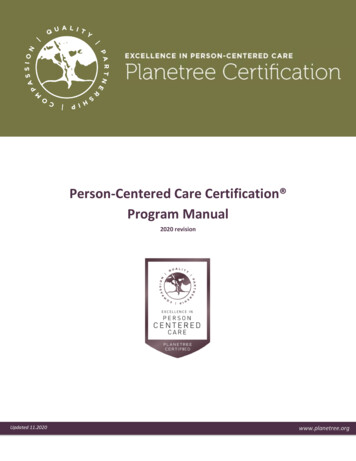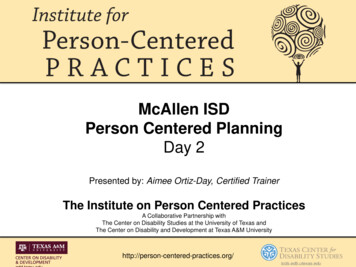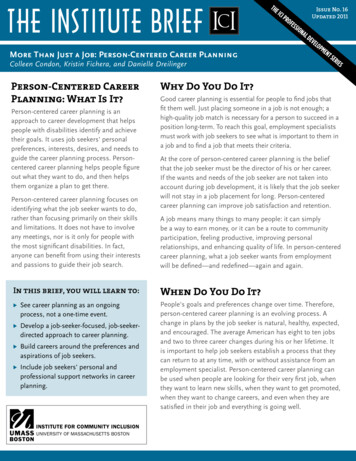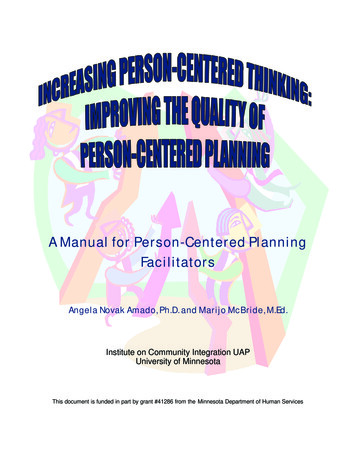
Transcription
A Manual for Person-Centered PlanningFacilitatorsAngela Novak Amado, Ph.D. and Marijo McBride, M.Ed.Institute on Community Integration UAPUniversity of MinnesotaThis document is funded in part by grant #41286 from the Minnesota Department of Human Services
Preparation of this report was supported by a grant from the Minnesota Department ofHuman Services. The content does not necessarily reflect an official position of the MinnesotaDepartment of Human Services or the University of Minnesota.The recommended citation for this manual is Amado, A. N. and Mc Bride, M. (2001), IncreasingPerson-Centered Thinking: Improving the Quality of Person-Centered Planning: A Manual forPerson-Centered Planning Facilitators. Minneapolis, Minnesota: University of Minnesota,Institute on Community Integration.The University of Minnesota is committed to the policy that all persons shall have equal accessto its programs, facilities, and employment without regard to race, color, creed, religion, nationalorigin, sex, age, marital status, disability, public assistance status, veteran status or sexualorientation.i
SOME NOTES ON USING THIS MANUALWe have seen that for both people who know little about Person-Centered Planning, and forthose who have been using the methods and ideas for a long time, the search for greaterunderstanding, power, and quality in the process is never-ending. There are many manualsalready available on how to facilitate Person-Centered Plans. This manual was prepared not toduplicate information already available, but rather to improve the quality of person-centeredplans that are being conducted.This manual was prepared as part of a two-year training project on Person-Centered Planningfunded by the Minnesota Department of Human Services and conducted by the Institute onCommunity Integration, University of Minnesota. This training was one part of a five-yeardemonstration project called Performance-Based Contracting, to determine the usefulness ofpersonal outcomes as a method of determining service quality.This manual is intended to be used as a resource in training programs on Person-CenteredPlanning. For those who have already had some or much training and experience in theseprocesses, we also intend this manual to be useful in improving the quality of facilitation.Most of the information contained herein uses the foundation of Personal Futures Planning. Werecommend that if people wish to use Essential Lifestyle Planning or PATH (PlanningAlternative Tomorrows with Hope) that they participate in the specific training programsdeveloped for those methods, which each start with a 3-day facilitator training.Some of the manuals which we recommend, in conjunction with specific training workshops, forspecific how-to methods include:PERSONAL FUTURES PLANNINGPerson-Centered Planning: Finding Directions for Change Using Personal Futures Planning,Beth Mount, Graphic Futures, Inc., 25 W. 81st St. #16-B, New York, NY 10024.Capacity Works: Finding Windows for Change Using Personal Futures Planning, Beth MountCommunitas, Inc., The Community Place, 730 Main St., Manchester, CT 06040.A Workbook for Your Personal Passport. Allen, Shea & Associates, 1040 Main St., Suite 200B,Napa, CA 94559.WHOLE LIFE PLANNINGWhole Life Planning: A Guide for Organizers and Facilitators. John Butterworth, David Hagner,Bonnie Heikkinen, Sherill Faris, Shirley DeMello, & Kristen McDonough. Institute forCommunity Inclusion, Children’s Hospital, 300 Longwood Ave., Boston, MA 02115.ESSENTIAL LIFESTYLE PLANNINGListen to Me! USARC/PACE, 410 Mason Suite 105, Vacaville, CA 95688.ii
Supporting People with Severe Reputations in the Community. Michael Smull & Susan BurkeHarrison, National Association of State Directors of Developmental Disabilities Services,113 Oronoco St., Alexandria, VA 22314.PATHPATH: A Workbook for Planning Positive Possible Futures, Jack Pearpoint, John O’Brien &Marsha Forest, Inclusion Press, 24 Thome Cres., Toronto, Ontario, Canada M6H 2S5.OTHERS“It’s My Life”: Facilitator’s Guide. Emilee Curtis & Milly Dezelsky. New Hats, Inc., HC 64Box 2509, Castle Valley, UT 84532Person-Centered Planning: A Guide for Facilitators. Debbie Gilmer & Alan Kurtz, Center forCommunity Inclusion, Maine’s University Affiliated Program, University of Maine,December 1995.iii
ACKNOWLEDGEMENTSThe material herein was developed as part of the Performance Based Contracting DemonstrationProject, a project operated by the Minnesota Department of Human Services with waivers and atraining grant from the federal Health Care Financing Administration. Five agencies providingresidential care in intermediate care facilities participated in this project.The Minnesota State Department of Human Services contracted with the University ofMinnesota’s Institute on Community Integration to provide training about Person-CenteredPlanning for two years to these provider agencies, the local Arc’s, and staff of other agenciesinvolved in the Performance-Based Contracting project. Fifty-three people participated infacilitator training and sixteen people participated in facilitator instructor training.We have to thank all of the facilitator trainees, focal people, and support circle members for theircontributions to this project and this material: The staff of the Minnesota Department of Human Services’ Division for Minnesotanswith Disabilities, especially Jan Kooistra and Theresa Mustonen. The staff, families, and persons served by ACR Homes, Bristol Place, Nekton,Heartland Homes, and New Directions. The people from other agencies who participated in the training project, including:Arc-Anoka Ramsey, Arc-Hennepin, Arc-Bemidji, Arc-St. Louis County, HennepinCounty Developmental Disabilities Division, and Rise.We also must thank the people from and with whom we have learned so much about PersonCentered Planning. We have reprinted material from many different people and sources, andwish to thank these people for their generosity, sharing of resources, and guidance:Marsha ForestDebbie GilmerBeth MountConnie O’BrienJohn O’BrienJack PearpointMichael Smulliv
REPRINT PERMISSIONAcknowledgements also go to the following people, from whom we have learned everything weknow about Person-Centered Planning. Reprint permission has been obtained from thefollowing people: Boggs Center, University Affiliated Program of New Jersey at UMDNJ for the material onpp. 27, 28, 29, and 32, reprinted from Building Person-Centered Support, Part One – Visionand Ideals, 1991. This material may not be reprinted without permission of the UAPNJ. Center for Community Inclusion, , University of Maine, for the material on pp. 24, 50-60,and the material on p. 38, “How Person-Centered is your Person-Centered Plan,” reprintedfrom Person-Centered Planning: A Guide for Facilitators, 1995. Marsha Forest and Jack Pearpoint, Inclusion Press, for the chart on p. 15. The learningchecklists on p. 13, “Musical Resources” on p. 62, and “Support Circles: the Heart of theMatter” on p. 23 are reprinted from Inclusion News. Additional information can be obtainedfrom the Inclusion News Web-page at: www.inclusion.com. Please see additionalinformation on ordering materials on pp. 74-77. Beth Mount, for material on pp. 21 and 22, reprinted from Person-Centered Planning:Finding Directions for Change Using Personal Futures Planning, 1997, and the material onpp. 78-79 reprinted from Capacity Works. The Person-Centered Planning manual can beordered from:Dr. Beth MountGraphic Futures, Inc.25 W. 81st St., 16-BNew York, NY 10024(212) 362-9492v
FACILITATORS MANUALCONTENTS1. Introduction And Background .12. Preparation Checklists.93. Qualities Of A Facilitator.144. Group Or Circle Constitution.195. Facilitating A Plan .256. Improving The Quality Of Plans .347. Evaluating The Quality Of A Plan.368. Follow Along Meetings/ Implementation Of The Plan.489. Difficult Group Members And Challenging Situations.5010. Music And Graphics .6111. Articles And Resources.6712. Person-Centered Planning Resource Materials.72vi
1. INTRODUCTION AND BACKGROUND1
INTRODUCTIONPerson-Centered Planning has been developed and evolved over the last fifteen-twenty years.Today the term is used to refer to a number of different styles of planning, all of which sharefundamental values. In this section we provide an overview of the fundamental concepts andprinciples underlying this approach to planning. Some of the leaders in the initial and on-goingdevelopment of Person-Centered Planning and its growth include Beth Mount, John O’Brien,and Connie O’Brien. Some of their central ideas are contained in the next few pages.Other leaders include Michael Smull and Susan Burke-Harrison, who developed a particularstyle of Person-Centered Planning called Essential Lifestyle Planning. ELP was initiallydesigned for people with challenging behavior, but has been used in many applications. MarshaForest and Jack Pearpoint were central in developing MAPS, initially used with planning schoolinclusion, and they have also developed a style of planning called PATH (Planning AlternativeTomorrows with Hope).This section provides an overview of the fundamental concepts, values, and principlesunderlying all Person-Centered Planning approaches. These ideas and values are probably themost important part of the process. One can master a technical style, but if the “heart and soul”of the process are missing, it is not Person-Centered Planning.2
According to John O’Brien and Herbert Lovett in Finding a Way Toward Everyday Lives, “theterm, Person-Centered Planning, refers to a family of approaches to organizing and guidingcommunity change in alliance with people with disabilities and their families and friends.” Theyalso state that each approach to Person-Centered Planning has distinctive practices, but all sharea common foundation of beliefs: The person at the focus of planning, and those who love the person, are the primaryauthorities on the person’s life direction. The purpose of Person-Centered Planning is learning through shared action. People whoengage in Person-Centered Planning may produce documentation of their meetings,proposals, contract specifications, or budgets. These are only footprints: the path is made bypeople walking together. Person-Centered Planning seems to change common patterns of community life. Segregation,devaluing stereotypes, and denial of opportunity for people with disabilities are common.Person-Centered Planning stimulates community hospitality and enlists community membersin assisting focus people to define and to work toward a desirable future. In order to support the kinds of community changes necessary to improve people’s chancesfor a desirable future, virtually all existing human service policies and agencies will have tochange the ways they regard people, the ways they relate to communities, the ways theyspend money, the ways they define staff roles and responsibilities, and the ways they exerciseauthority. Honest Person-Centered Planning can only come from respect for the dignity andcompleteness of the focus person. Assisting people to define and pursue a desirable future tests one’s clarity, commitment, andcourage. Person-Centered Planning engages powerful emotional and ethnical issues and callsfor sustained search for effective ways to deal with difficult barriers and conflicting demands.Those who treat Person-Centered Planning simply as a technique and those who fail toprovide for their own development and support will offer little benefit to the people they planwith.3
Beth Mount comments on the dichotomies between system-centered and person-centered waysof thinking about an individual’s future in her 1992 sourcebook “Person-Centered Planning:Finding Directions for Change Using Personal Futures Planning”:HOW DO WE THINK ABOUT AND PLAN FOR THEFUTURE?Person-centered change challenges us to discover and invent a personal dream for people, tocraft a pattern of living that increases people’s participation and belonging in community life.FromTowardSYSTEM-CENTEREDPERSON-CENTERED Plan a lifetime of programs Craft a desirable lifestyle Offer a limited number of usuallysegregated program options Design an unlimited number ofdesirable experiences Base options on stereotypes aboutpersons with disabilities Find new possibilities for each person Focus on filling slots, beds, placements,closuresOveremphasize technologies andclinical strategiesOrganize to please funders, regulators,policies, and rules Focus on quality of life Emphasize dreams, desires, andmeaningful experience Organize to respond to peopleO’Brien and O’Brien’s “five valued experiences” (Framework for Accomplishment, 1989) alsolead to other questions on which to focus in developing a more desirable future:COMMUNITY PRESENCE:How can we increase the presence of aperson in local community life?COMMUNITY PARTICIPATION:How can we expand and deepenpeople’s friendships?PROMOTING CHOICE:How can we help people have morecontrol and choice in life?SUPPORTING CONTRIBUTION:How can we assist people to developmore competencies and contribute theirunique gifts?VALUED ROLES:How can we enhance the reputationpeople have and increase the number ofvalued ways people can contribute?4
Beth Mount has also described the differences in images of the future in traditional programplans compared to futures that are worth working for. The images of a future worth working forcan result only from a more person-centered process.CONTRASTING IMAGES OF THE FUTURECHARACTERISTICS OFTRADITIONAL PROGRAM PLANS:CHARACTERISTICS OF A POSITIVEFUTURE WORTH WORKING FOR:Goals focus on specific negative behaviorsof the focus person to change or decrease.Images of the future contain specific,concrete examples of positive activities,experiences, and life situations to increase.The plan identifies program categories andservice options that are often segregated.Ideas and possibilities reflect specificcommunity sites and settings and valuedroles within those settings.Many goals and objectives reflectpotentially minor accomplishments thatcan be attained within existing programswithout making any changes.Some ideas will seem far out, unrealistic,and impractical, and will require majorchanges in existing patterns such as:funding categories, service options, howpeople (and staff) spend their time, shareddecision making, where people live andwork, etc.These plans will look similar to the plansand ideas written for other people.These plans will really reflect the uniqueinterests, gifts, and qualities of the person,and the unique characteristics, settings, andlife of the local community.These plans will probably not evenmention personal relationships orcommunity life.These ideas will emphasize creative waysto focus on the development and deepeningof personal relationships and communitylife.In “What We Are Learning About Circles of Support,” by Mount, Ducharme, and Beeman(1989), three types of planning for people with disabilities are contrasted. This comparison is onthe next three pages. The type most “true” to original concepts of Person-Centered Planning areCircles of Support. Such circles often require sustenance outside of formal systems. Some moretraditional and formal teams have tried to adapt themselves to operate according to more personcentered principles, and their efforts and style are represented in the column called “PersonCentered Teams.”5
A COMPARISON OFTHREE TYPES OF PLANNING FOR PEOPLE WITHDISABILITIESTRADITIONAL PLANNINGPERSON-CENTERED TEAMSCIRCLES OF SUPPORTPURPOSE OF THE PLANNING M EETINGTo coordinate servicesacross disciplinary lines.To clarify staff roles in theimplementation of trainingprograms.To establish a commonvision for all participants.To discover informationneeded to focusorganizational change.To establish and support apersonal vision for anindividual. To buildcommunity support andaction on behalf of thefocus person.Professionals, direct serviceworkers. May includefocus person and family.Focus person and hisspokesperson, family,friends, and associates.May include some humanservices workers.COMPOSITION OF THE TEAMProfessionals and specialistsWHERE DOES THE TEAM M EET?Human service settingconference room:centralized site.Human Service Settingclose to direct serviceworkers: group home,workshop: decentralizedsite.Community settings: livingroom, church room, andlibrary meeting room.Places close to wheremembers live.HOW OFTEN DOES THE GROUP M EET?Once a year with quarterlyreviews.Major investment in initialsessions. Quarterly ormonthly reviews.6Once a year with many submeetings in between forongoing problem solving.
TRADITIONAL PLANNINGPERSON-CENTERED TEAMSCIRCLES OF SUPPORTWHO INITIATES THE M EETING FOR WHAT PURPOSE?Team Leader initiates tomeet requirements ofregulations.Organizational changeagent initiates to find newdirections for theorganization.Focus person orspokesperson initiates toreach goals they are unableto accomplish workingalone.WHAT M OTIVATES PEOPLE TO ATTEND THE M EETING?Avoidance of punishmentby regulators. Interest incoordination ofdepartmental units.Interest in organizationalinnovation and finding newdirections for focus person.Voluntary commitment bypeople who are interested inhelping someone they carefor.NATURE OF THE IMAGES FOR THE FUTURE:Goals will fit withinexisting program options.Goals will reflect newprogram models andoptions yet to be developed.Vision will reflect desire offocus person and family.ROLES OF M EMBERS AND BOUNDARIES FOR ACTION:Members have specificroles and clear boundariesfor action. Plans do notchange roles or boundaries.Members act within formalexisting organizationalchannels of authority.Members roles will changebased on new directions.Old boundaries for actionmay be changed to allowfor new action. Plans maychange roles and create newagendas for action.Members create newchannels and connections toaccomplish their goals.Participant roles areconstantly changing basedon tasks. Boundaries foraction are defined bypersonal vision andcommitment of groupmembers. Members useinformal networks andcontacts to open doors incommunity.PRODUCT OF AN EFFECTIVE GROUP M EETING:Completed forms,paperwork. Specific goalsto use to evaluate programeffectiveness.An agenda fororganizational change.A shared understanding ofnew directions for change.7Commitments to action bycommunity members.Significant quality of lifechanges for the focusperson.
TRADITIONAL PLANNINGPERSON-CENTERED TEAMSCIRCLES OF SUPPORTROLE OF HUMAN SERVICE WORKER:Set all direction. Organizeall activity. Coordinatedirect service workeractivities.Mediate interests ofproviders and focus person.Lead organizational changeefforts. Listen to directservice workers.Support directions definedby the group. Increaseknowledge of availableresources. Provide directservices to focus person.ROLE OF COMMUNITY M EMBER:Not involved in the process.May help implement someideas.Generate and implementplan and action steps.ROLE OF PERSON WITH A DISABILITY:Comply with the plan.Cooperate in thedevelopment of the plan.Direct plan and activities.From: What are We Learning About Circles of Support by Beth Mount, Bat Beeman, andGeorge Ducharme. Available from Communitas, P.O. Box 374, Manchester, Connecticut06040.Reprinted with the permission of the Boggs Center (1991), UAPNJ at MNDN. May not be reprinted withoutpermission.8
2. PREPARATION CHECKLISTS9
CHECKLIST FOR PERSON-CENTERED PLANNINGMEETING PREPARATIONPRE-WORK FOR THE FACILITATOR TO DO OR ENSURE IS DONE BY PERSONCOORDINATING THE MEETING PRIOR TO THE MEETING: What are the right processes for the person, the team/support circle and the person’ssituation?Is there a committed champion who will make sure the plan remains alive?Has the planning process been discussed with the support circle members? Do they haveinformation on the process and time requirements?Have circle members had input to the decision about the planning process?Have you discussed with the person coordinating the meeting which parts of which processwill be used, how to address the current issues, etc.?THE FACILITATOR SHOULD BE RESPONSIBLE FOR ENSURING THEFOLLOWING: Has the meeting preparation been a coordinated effort? Either clear or ensure that thedifferent members (person served, residence, day program/employment, case manager,family, etc.) have been cleared regarding the meeting format and who will do that. Is this meeting serving as meeting the annual or any other requirements? Are circle memberslearning whether this is a separate or the only process? If necessary, set a meeting timeseparate from the annual meeting to help team members have a different frame of mind andto think outside the service system box. If Person-Centered Planning formats are going to beused as a substitute for annual or other requirements, ensure that the case manager, dayprogram, and residence are all clear about the formats that will be used. Has the residence coordinated with the day program that the format is that of a “circle” groupprocess, not one agency “doing their part,” then another agency “presenting their part” duringthe meeting (including/especially if this process is used for annuals or other meetingsrequired by one of the agencies involved)? Who will facilitate, record, etc., during different parts of the meeting? Is the meeting location comfortable and does it meet the space requirements needed (forinstance, where will posters be hung?) Have preparations been coordinated with the focus person? Have invitations been sent to allthe members the person wants? Have people been invited who are beyond the traditionalteam and who can help the person identify a desirable future? Is the focus personcomfortable about the process? Is there a welcoming environment (food, flowers, balloons, candles, etc.)?10
Do you have paper, markers, tape, etc.? Do any ground rules need to be set for the circle? Are there any topics, words, or phrases to avoid?AT THE MEETING: Help the focus person decide where they want people to sit, if possible. Does the seatingarrangement ensure that everyone is included and no one appears more important? Ask about timelines, times people need to leave. Set up ground rules. Use them. Will breaks be needed? How often?AT THE END OF THE MEETING: How will copies of what has been done get to people who need them? When will the next meeting occur?11
EXAMPLES OF GROUND RULESGROUND RULES FOR ESSENTIAL LIFESTYLE PLANNING1.2.3.4.5.Be respectfulNo jargonNo fixingNo obsessingHave funGROUND RULES FROM PATH1.2.3.4.5.The right people are hereIt begins when it begins and ends when it endsDo what you need to do to be hereWhatever happens is the only thing that could have happenedDo unto others .If #5 doesn’t work, TEXAS RULE: Be nice or GET OUTLISTEN (really listen)ASK (for what you want, assistance for help to pursue questions)CONTRIBUTE (when moved)12
Introductory MAPS learning checklistI have Watched the Shafik’s MAP videoRead All my life’s a circle, pp. 1-28Action for inclusionWhat’s really worth doingFrom behind the pianoAnswered the sequence of MAPS questions reflectively, for myself,with facilitation, and provided the facilitator/ recorder with feedback.Facilitated another person in answering the MAPS questions, andreceived feedback on my facilitation.Made a graphic record of another person answering the MAPSquestions and received feedback on my recording.Developed a set of notes for myself on “What I want to review before Ifacilitate a MAP.”Made agreements with at least two other people who will support mypractice with MAPS by encouraging me and debriefing with me.Identified a family I will approach to be my partners in taking the nextstep by allowing me to facilitate a MAP with them.Introductory PATH learning checklistI have Watched the Introductory PATH training video.Read All my life’s a circle, pp. 29-43PATH WorkbookBeen a PATHfinder on an issue that matters to me, and provided thefacilitator and recorder with feedback (i.e., I have had my own PATHdone)Facilitated another person’s PATH, and received feedback on myfacilitation.Acted as a graphic recorder for another person‘s PATH and receivedfeedback on my recording.Developed a set of notes for myself on “What I want to review before Ifacilitate a PATH.”Made agreements with at least two other people who will support mypractice with PATH by encouraging me and debriefing with me.Identified a person or group I will approach to be my partners in takingthe next step by allowing me to facilitate a PATH with them.Reprinted with permission from Inclusion News.13
3. QUALITIES OF A FACILITATOR14
Reprinted with permission from Marsha Forest and Jack Pearpoint.15
LEVELS OF COMMITMENT TOPERSON-CENTERED PLANNINGEMBRACESUPPORTBELIEVENEUTRALYES BUT16
TRAITS OF A PERSON-CENTEREDPLANNING FACILITATORQUALITIES/ DECLARATIVE – THE WHATA GOOD FACILITATOR:1. Believes in the Person-Centered Planning philosophy2. Holds a true understanding of the assumptions of Person-Centered Planning3. Is committed to the Person-Centered Planning process4. Supports the Person-Centered Planning process5. Understands and implements the logistical techniques of Person-Centered Planning,including: Supporting the focus personInviting appropriate group membersFostering a welcoming environment that supports creativityGraphics skillsGroup facilitation skills6. Fosters commitment and support from members of the support circle to the Person-CenteredPlanning process and the action plan7. Uses humor!A GOOD FACILITATOR IS:8. Non-Judgmental9. A Good Listener10. Self-Confident11. Flexible12. Genuine13. Hospitable17
PROCEDURES AND PROCESS – THE HOWA GOOD FACILITATOR:1. Knows how to facilitate a person-centered plan.2. Uses pacing to move the Person-Centered Planning process along at a rate that works for thefocus person and the circle of support.3. Uses good listening skills.4. Uses team work to enhance the effectiveness of the Person-Centered Planning process.5. Resolves any conflict constructively.6. Uses consensus building.7. Fosters the self-determination of the focus person so the person-centered plan is created byand with them and not for them.8. Builds relationships with the members of the circle of support so they will participate in thework of the action plan on an ongoing basis.9. Helps the group CELEBRATE successes and accomplishments, and grieve over upsets andbreakdowns.18
4. GROUP OR CIRCLE CONSTITUTION19
GROUP OR CIRCLE CONSTITUTIONA Person-Centered Planning circle is not the same as a person’s interdisciplinary “team.”One of the best ways to determine who should be in a circle is for the facilitator to sit down withthe focus person (and/or their representative, if needed) and draw a relationship map. The firstquestions to ask would be “Who are your best friends?” “Who do you love the most?” “Wholoves you the most?” Then the facilitator can fill in the rest of the map with the person and/ortheir representative.The facilitator can also ask about community places the focus person goes to, and who they seethere. The facilitator can actively seek out who are community members who can be invited tojoin the person’s circle.Once the map is complete, the facilitator asks the person who they would like to have participatein this planning. Then together they figure out how these people should be invited to come to theplanning meeting.20
INTER-VISIONARY TEAMA planning group that is true to the principles of Person-Centered Planning does not cometogether because of professional roles and requirements. A Person-Centered Planning group isconstituted of people who want to contribute their time and talents because they care about theparticular focus person and want to work for change.AN IDEAL PERSON-CENTERED PLANING GROUP CONSISTS OF A VARIETY OFPEOPLE AND ROLES:Family members - provides a historical perspective, strong alliance with the focus personHomemaker – is the guardian of hospitality for the circlePersonal assistants – are responsible for day-to-day responsiveness to the personWarrior – focuses on immediate and long-range actions to help implement the planTeacher – provides information and skills to the circle to help implement the planCommunity builder – may have many connections, invites and brings others into the circle andthe person’s life, both to strengthen the circle and help in implementing the planAdministrative ally – can see and advocate for administrative changes that might be needed bothfor this focus person and for long-term changeMentor – can provide information, guidance and insight that will help in long-term changeBenefactor – may assist in providing what’s needed for long-term changeSpiritual advisor – renews the faith of the person and the group over timeF
personal outcomes as a method of determining service quality. This manual is intended to be used as a resource in training programs on Person-Centered Planning. For those who have already had some or much training and experience in these processes, we also intend this manual







